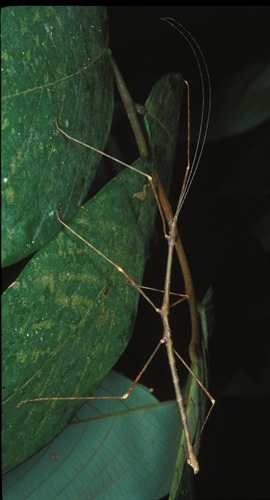
Back
Acacus sarawacus (Westwood, 1859)
| Family Name: | Heteronemiidae |
| Taxonomic Group: | Invertebrates (Stick Insect) |
| Common Name: | White-kneed Stick Insect |
Name
Ecology, Habitat & Location
| Ecological Notes | All of the insects belonging to the subfamily Necroscinnae are very specialised feeders. Acacus sarawacus lacks wings and is therefore not capable of flight; it is ground dwelling. This may restrict its range to the immediate vicinity of its food plants. It occurs in primary and in undisturbed secondary forests as long as food plants are present. It requires a very humid environment. |
|---|---|
| Habitats | Forest, Terrestrial |
| Distribution | Acacus sarawacus only occurs in Singapore and Borneo. It can still be found in Singapore. Its range is very restricted as it is only found at one particular area near the MacRitchie Reservoir. |
| Nature Reserves | Central Catchment Nature Reserve |
Conservation
| Trends & Threats | The main threat to these phasmids, which are very specialised plant feeders, is the destruction of their foodplants. Other reasons for their scarcity may be due to other very specific environmental requirements such as humidity, light and temperature. All are very sensitive to misuse of insecticides. |
|---|---|
| Scientific Interest & Potential Value | They have an ability to regenerate lost limbs during their nymphal stages. Genetic studies of these insects may in time allow humans to trigger the genes in our own bodies that may regenerate lost lims as well. Many of these insects are also able to reproduce by parthenogenesis or without being fertilised by the males. This also makes it interesting for research into reproduction science. |
| Conservation Notes | Conservation of forests and preservation of the original forest habitats are most important for the continued survival of these species. Its known locality is protected within the Central Catchment Nature Reserve. |
Status
| Species Status | Native |
|---|---|
| Singapore Red Data Book Status | Endangered (EN) [2008] |
Photos
References
| References | Davison, G.W.H., Ng, P.K.L. & Ho, H.C (Eds.). 2008. The Singapore Red Data Book (2nd Edition). Singapore: Nature Society (Singapore). 285pp |
|---|
